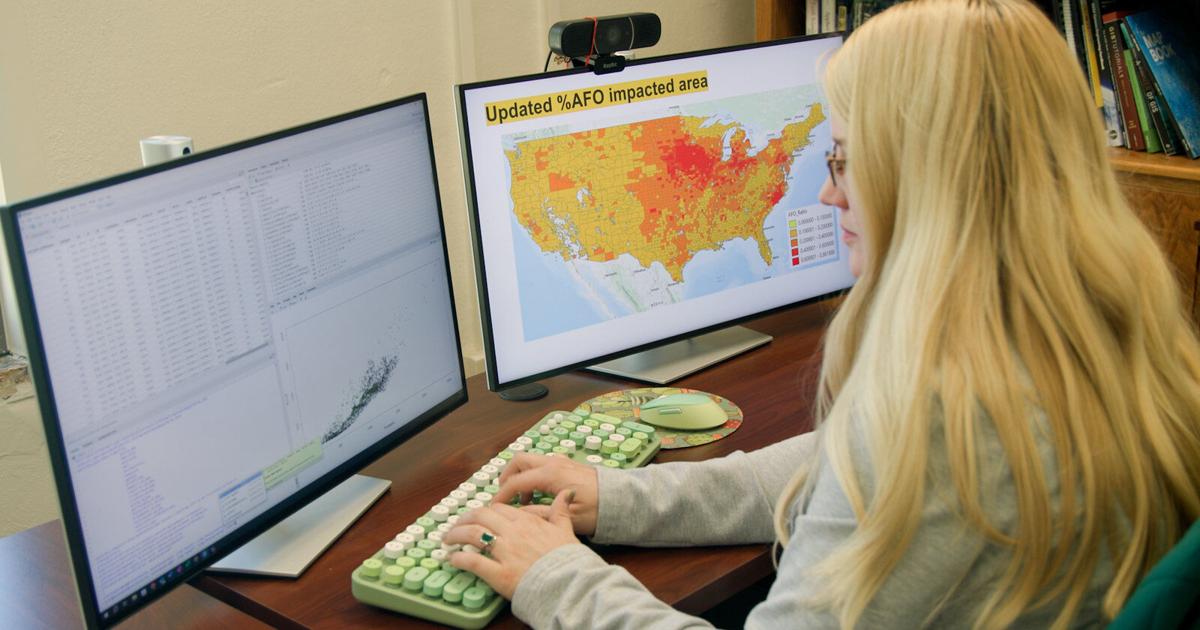Understanding where farm animals are raised is crucial for managing their environmental impacts and developing technological solutions, but gaps in data often make it challenging to get the full picture.
Becca Muenich, biological and agricultural engineering researcher, set out to fill the gap with a new technique for mapping animal feeding operations.
Without proper control strategies, the waste generated by these operations can pose significant ecological harm, Muenich said, such as surface water contamination with excess phosphorus and nitrogen. Animal feeding operations are defined as facilities that feed animals for at least 45 days per year in a confined area that does not grow grass or forage. For Muenich, a water quality engineer who focuses on how water moves through landscapes and how it can pollute areas by picking up and moving toxic materials, this issue piqued her interest.
“We can’t really address something if we don’t know where the problem is,” said Muenich, an associate professor with the College of Engineering at the University of Arkansas and researcher for the Arkansas Agricultural Experiment Station, the research arm of the University of Arkansas System Division of Agriculture.
“We don’t have a good nationwide — even at many state levels — understanding of where livestock are in the landscape, which really hinders our ability to do some of the studies that I was interested in,” she said.
Muenich said there has been a rise in these feeding operations in response to increasing population size and global demand for livestock products.
Considering key predictors of feeding operation presence such as surface temperature, phosphorus levels and surrounding vegetation, Muenich’s team built a machine learning model that can predict the location of feeding operation locations without using aerial images. Machine learning models are a type of computer program that can use algorithms to make predictions based on data patterns.
The model was developed using data encompassing 18 U.S. states. The data was broken up into individual parcels based on ownership. Testing against a dataset of known animal feeding operations, the model predicted their location with 87 percent accuracy.
The study, “Machine learning-based identification of animal feeding operations in the United States on a parcel-scale,” was published in Science of the Total Environment in January.
FILLING IN THE GAPS
Previous attempts at identifying animal feeding operations have often relied on aerial images, Muenich said, but livestock facilities often look different between states and by animal, so she and her team aimed to employ further strategies.
She explained the lack of understanding surrounding livestock locations often comes from differences in how states interpret the Clean Water Act, which requires farms classified as “concentrated animal feeding operations” to get permits through the National Pollutant Discharge Elimination System. These facilities are a type of animal feeding operation with more than 1,000 animal units.
Despite the national regulation, states administer this permitting differently, leading to differences in available data.
For example, Muenich built a watershed model in an area of Michigan and Ohio that included multiple feeding operations. Data was readily available through the pollutant elimination system for Michigan due to the state’s permitting requirements. The same data, however, wasn’t available for the same operations in Ohio, which set Muenich down this path of investigation.
Advancing towards a better accounting of livestock can help with developing strategies that can improve environmental outcomes of livestock management while creating economic opportunities for farmers through the scaling up of technologies aimed at combating animal waste, Muenich said. Scaling these technologies in economically feasible ways requires knowledge of where livestock are most prevalent and spatially connected, she explained.
Co-authors of the study included Arghajeet Saha, formerly a postdoctoral researcher at the University of Arkansas and currently an assistant scientist with the Kansas Geological Survey; Barira Rashid, Ph.D. student at the University of Arkansas; Ting Liu, a research associate with the University of Arkansas biological and agricultural engineering department; and Lorrayne Miralha, an assistant professor with The Ohio State University’s department of food, agricultural and biological engineering.
The research was supported by the Science and Technologies for Phosphorus Sustainability Center under National Science Foundation award number CBET-2019435. The Data with Purpose program from Regrid, a source for nationwide land parcel data, provided data used in the research.
Your Facebook page may have a few hundred or a few thousand friends, most of whom don’t check your page frequently. Get your news or organization noticed by more than 11,000 daily visitors by sending information to our email address:
magnoliareporter.com is moving away from its social media account on X (formerly Twitter). Join us on Bluesky by downloading the Bluesky app and becoming a member. See what we post at @magnolia-reporter.bsky.social .
